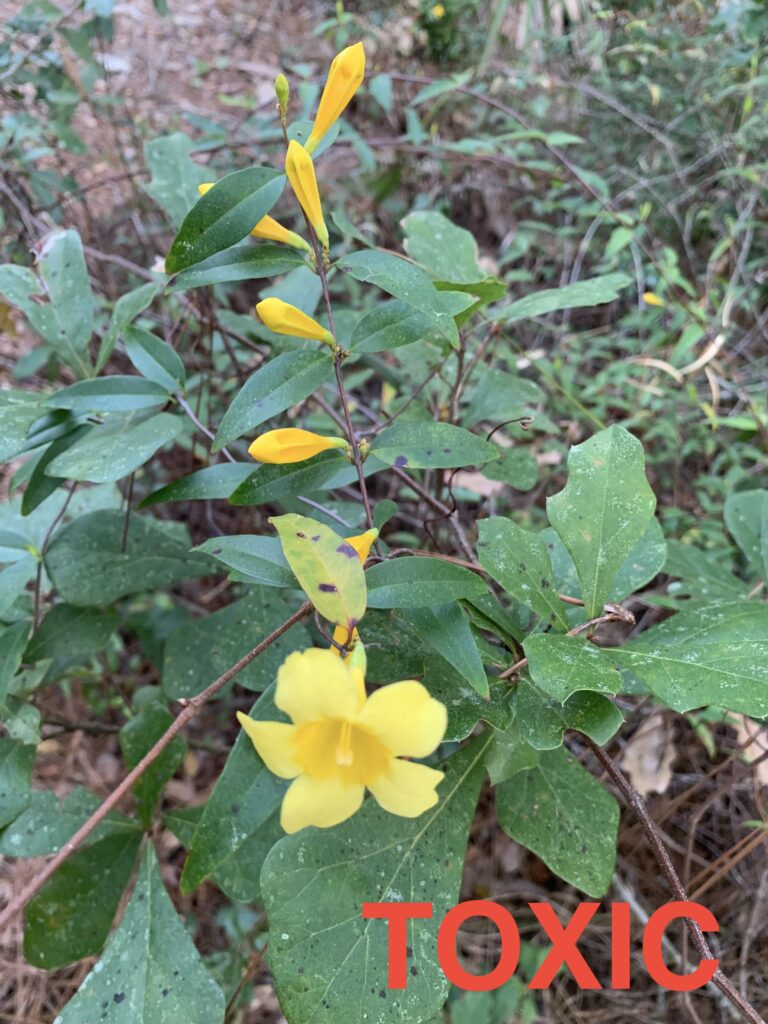
Consuming Carolina Jasmine will make you sick. Handling it with cuts on your hand might also be toxic. Photo by Green Deane
Toxic Carolina jasmine(Gelsemium sempervirens) is tempting. Jasmine is a friendly name, and the blossoms are alluring. This relative of the Honeysuckles has a sweet poisonous sap and is a common killer of plant-eating dogs. Farm animals it has killed include cattle, goats and geese but is not toxic to deer. It has also has sickened children who consume its nectar. Alkaloids are found in all parts of the plant, especially in the flowers and roots. The alkaloids act on nerve endings causing paralysis, muscle weakness, and convulsions. At high doses the alkaloids act centrally on the nervous system against gamma-amino butyric acid (GABA) causing convulsions and respiratory failure. Water Hemlock also kills by working against GABA.
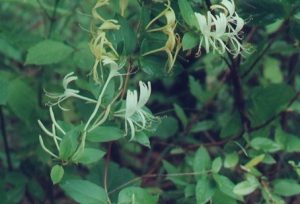
Japanese Honeysuckle has edible nectar.
There’s no shortage of research on the native species. It has had some medicinal uses, particularly for mental issues as a nervous system relaxant. And it might have some anti-cancer activity. All parts of the plant are toxic. According to one scientific paper “It has been used in treatment of spasmodic disorders such as asthma and whooping cough. The plant has been used in hysteria, dysmenorrhea, chorea, pneumonia and bronchitis.” I have tasted the nectar at the base of one yellow blossom. As far as I could tell that had no significant effect on me.

Invasive Cat’s Claw is not edible.
Japanese honeysuckle (Lonicera japonica, photo upper right) can also have yellowish blossoms but you will notice the tubular blossoms have Long stamens and and an inferior ovary. Japanese honeysuckle blossom nectar is edible. Carolina Jasmine also looks similar to Cat’s Claw (Dolichandra unguis-cati, photo at left) which is not edible and is toxic to parrots. The invasive species got its name from claw-like thorns that grow on the stem. In Folk medicine it is use as an anti-inflammatory. If the flowers are red-orange it is the native cross-vine Bignonia capreolata, also not edible.
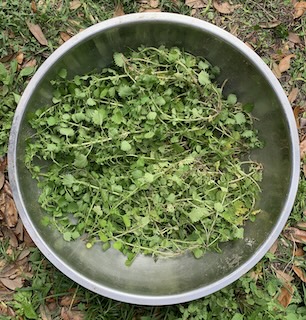
Stinging nettles with roots and dirt removed. Photo by Green Deane
Stinging nettles sting me badly, but I can eat them. If they sting me I get a bloody welt that takes weeks to heal. As I saw a patch of them this morning and collected a bunch for drying and future use in soups and stews. I wore motorcycle gloves — all I had — and got stung twice. Stinging Nettles have vitamin A, potassium, magnesium, and calcium. They also have protein and when cooked are very mild tasting similar to spinach but slightly rougher. From my book: “Calcium tops the nutrition list with 481 mg per 100 gram serving (which passes for 3.5 ounces.) Next is potassium at 334 mg, followed by phosphorus 71 mg and magnesium 57 mg. Vitamin A, as beta carotene, is at 2011 IU.There are traces of zinc, copper, manganese, selenium and some B3 and B6. In micrograms there’s 4178 mcg of the vision twins, Lutein+zeaxathin, and interestingly 498 mcg of Vitamin K, phylloquinone.” To learn more about the Heartleaf Nettle go here. For a video, here.
Can you eat red mangroves? If you had nothing else to eat, yes. For many people Red Mangroves are just a shoreline obstruction. But they are an emergency food, a source of salt, tea, even cattle fodder. At one time, some 70 years ago, the leaves were dried, powdered, and sold as a supplement.
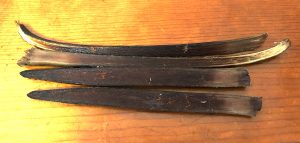
Red Mangroves propagules cooked. Photo by Green Deane.
If you are inclined to eat them boil the seed pods (they really aren’t seed pods but for convenience let’s call these propagules seed pods.) Many folks write that they are bitter. I have not found that to be so. To me they are mealy, slightly dry and tasteless, like sandy grits perhaps, best mixed with something with a lot of flavor. I boil the pods, cool, cut them in half, scrape out the starchy inside, then boil or soak them again. A tea can be made from the leaves but it is recommended it be served with milk to bind with the high amount of tannin. Indeed, the leaves were once considered as the base material for human protein supplementation. However the high tannin content, 11.68%, made that prohibitive (in the 1950s.) And you can get salt off the leaves. You can read more about the red mangrove here.
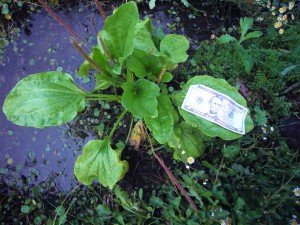
Plantago rugulii is a large local plantago. Photo by Green Deane
Plantago Power: It was a dark and rainy … morning… and I was searching through the gloom along the road for a wild mustard/radish for my foraging class. It was cold. It was rainy. It was gray. Something caught my eye so I pulled Van Go over and headed towards a watery ditch. Then I heard a baby cry. Seriously. The figure I thought was a bag lady with stuffed shopping cart was a bundled-up woman with a baby stroller waiting for a bus. Things look different in the dim drab of winter. And the plant I thought might be a mustard most certainly was not. It was a Plantago, the largest one I have ever seen. That was worth a picture and posting on the Green Deane Forum. There one of our regular members, Josey, who has an eye for detail and a whole lot of knowledge, offered it as Plantago Rugelii rather than P. major. One difference is the P. rugelii has purple at the base of the petiole, P. major is white. Unlike P.major, which is from Europe, P. rugelii is native to North America. It is odd that we don’t hear more about it. You can read about it here and watch a video here.

Foraging classes are held rain or shine, heat or cold. Photo by Nermina Krenata
Foraging Classes: Good weather is predicted for the upcoming weekend for foraging.
Saturday, February 17th, Bayshore Live Oak Park, Bayshore Drive. Port Charlotte, meet at the parking lot at Bayshore and Ganyard, 9 a.m. to noon.
Sunday, February 18th, Wickham Park: 2500 Parkway Drive, Melbourne, FL 32935-2335. 9 a.m. to noon, Meet at the “dog park”,
Saturday, February 24th, Mead Garden: 1500 S. Denning Dr., Winter Park, FL 32789. 9 a.m. to noon. Meet at the bathrooms.
Sunday, February 25th, Eagle Park Lake, 1800 Keene Road, Largo, FL 33771. Meet at the pavilion near the dog park. 9 a.m. to noon.
To read more about the classes, to pre-pay or sign up, go here.

You get the USB, not the key.
172-video USB would be a good end of spring present and is now $99. My nine-DVD set of 135 videos has been phased out. The USB videos are the same videos I have on You Tube. Some people like to have their own copy. Most of the 172 USB videos have to be copied to your computer to play. If you want to order the USB go to the DVD/USB order button on the top right of this page. That will take you to an order form.

Green Deane Forum
Want to identify a plant? Perhaps you’re looking for a foraging reference? You might have a UFO, an Unidentified Flowering Object, you want identified. On the Green Deane Forum we — including Green Deane and others from around the world — chat about foraging all year. And it’s not just about warm-weather plants or just North American flora. Many nations share common weeds so there’s a lot to talk. There’s also more than weeds. The reference section has information for foraging around the world. There are also articles on food preservation, and forgotten skills from making bows to fermenting food.
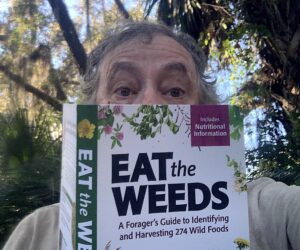
Finally, a physical copy of the book.
Now in print is EatTheWeeds, the book. It has 275 plants, 367 pages, index, nutrition charts and color photos. It’s available in many locations including Amazon. Most of the entries include a nutritional profile. It can also be ordered through AdventureKeen Publishing.
This is weekly newsletter #587. If you want to subscribe to this free newsletter you can find the sign-up form in the menu at the top of the page.
To donate to the Green Deane Newsletter click here.

